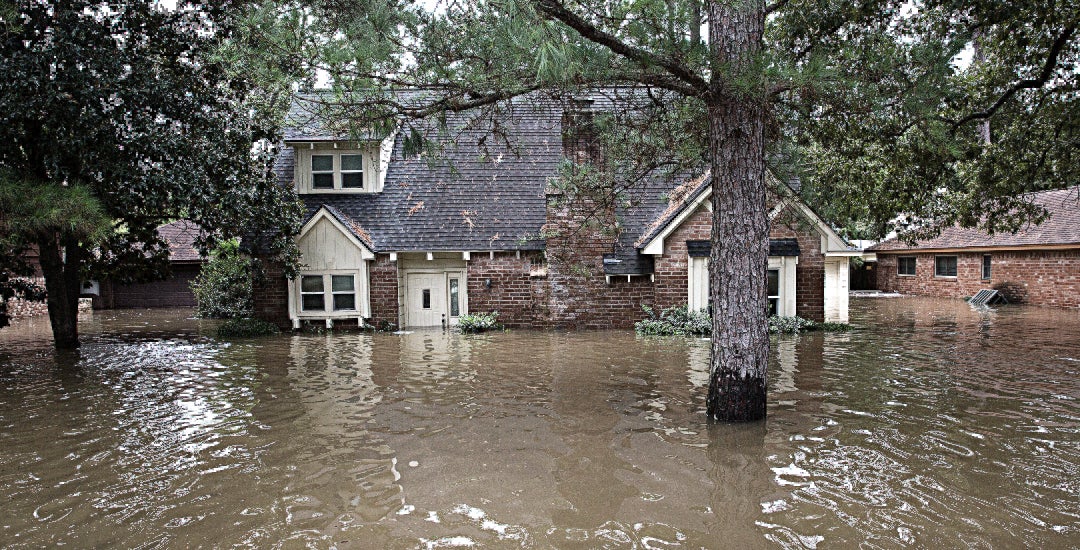These costs, along with rising costs like homeowners insurance, may further contribute to Houston, long known for its housing affordability, no longer being able to deliver on that promise.
“The low costs of housing, relatively speaking in Houston, had a hidden cost that was always there,” said Jim Elliott, a sociology professor at Rice University who has researched inequities in disasters and recovery. “It just wasn't factored into rising insurance premiums that reflected the real costs and risks—and that's becoming manifest.”
The cost of flood insurance
Over 95% of flood insurance policies are purchased through the National Flood Insurance Program (NFIP), which the U.S. government created in 1968 after most private insurers gave up on providing such coverage. The program had two major aspirations: providing financial relief via subsidized insurance and also encouraging better land-use planning by states and local governments, such as restricting building in areas at high risk of flooding to begin with.
But the latter essentially did not happen, and today more people live in a floodplain, an area at risk of flooding, than before the NFIP was created.
“There are many people who blame the National Flood Insurance [Program] for encouraging people to build in places they never should have built,” Elliott said. Indeed, from 1970 to 2010, the population in coastal counties grew by 40%.
Nowhere is this more true than in Harris County, which has a third of its land area in a floodplain and has grown by 176% since 1969, with development that exacerbates flooding continuing unabated.
“[Flood insurance is] a way for developers basically to displace the risk of what they're developing. … ‘I might be developing new housing in a floodplain, but I'm not responsible for the consequences–it's an individual's responsibility,’” Elliott said.
Add to all this risky coastal development an increase in flooding caused by climate change supercharging storms, and FEMA, which administers the NFIP, has been deluged by debt in the wake of billions of dollars of damage wrought by hurricanes like Katrina, Sandy and Harvey.
Another issue compounding the NFIP’s financial difficulties is repetitive loss, Elliott said, referring to properties that have repeatedly flooded and received payments.
“There are instances in Houston where a house that might be valued at a couple $100,000, has actually had more than a million dollars in payouts because it's flooded six times—that's just not a winning formula for a government program,” Elliott said.
A flawed solution
In order to better price flood risk, make the program more equitable, and shore up the agency’s finances, FEMA has begun rolling out a restructuring of the NFIP called Risk Rating 2.0 for the past two years.
As David Maurstad, a senior FEMA official in charge of the NFIP told E&E News in May FEMA also hopes this will better communicate the increasing flood dangers in a time of intensifying climate change.
The new risk rating means the annual price of a flood insurance policy will increase — once fully implemented, doubling the average price, from $888 today to $1808. Harris County is projected to see a 75% increase in average premiums, though in a single year, prices can only increase by 18% under federal law. New flood maps for Harris County are also due to come out later this year, which could lead to price increases for an even larger amount of people in the region.
FEMA’s retooling of flood insurance will place more of the financial onus on the people living in risky areas. But for many current homeowners in floodplains, some may end up forgoing flood insurance altogether if it becomes too expensive. A Houston Chronicle analysis last October found that one in 12 property owners had already dropped their flood insurance policies.
Nevertheless, flood insurance policies are required for property owners with government-backed mortgages in high-risk flood areas, and many other lenders require it as well, which could possibly lead to someone no longer being able to live in their home at all.
“It's a step backwards, and maybe literally a step out of their housing that they can no longer afford,” Elliott said.
And if people can’t afford flood insurance, they may very well be out of luck the next time their home floods: Under a 1988 disaster recovery law, you can only claim FEMA individual assistance for a property once without flood insurance.
Community advocates also say that FEMA’s implementation of Risk Rating 2.0 fundamentally does not address deeper inequities in the flood insurance system as it exists today.
“The price for families that [are lower income] is too high, and the price for extremely wealthy families is too low,” said Ben Hirsch, co-director at West Street Recovery, a grassroots organization focused on disaster recovery in Houston. His organization last year began an initiative of paying the premiums of flood insurance policies for people who needed them. Exacerbating the cost are other hurdles, such as the fact that flood insurance is a one-time annual payment. “Most of the families we work with, that's about a month's income—that's just not affordable.”
To its credit, FEMA has advocated for a subsidy program of some sort, but such a program requires Congressional approval, which so far has yet to garner support among Republicans, who currently control the House of Representatives. In the meantime, concerns over affordability have now led to 10 states (including Texas) and many local governments suing FEMA to block the rate increases.
However, supposing people can maintain flood insurance, there are also disparities in how much aid people can get.
“There's this distributional justice problem,” Hirsch added, “because what happens to wealth distribution after disasters is that rich people get richer after disasters, and insurance payouts are a big part of that.”
As sociology professors Anna Rhodes and Max Besbris describe in their book, "Soaking the Middle Class: Suburban Inequality and Recovery from Disaster," disasters like Hurricane Harvey can heighten inequalities even in seemingly uniform middle-class communities, as some come away with more resources while others get stuck in a cycle of repairs and downward mobility. Elliott's own research finds that “wealth inequality actually increases at a steeper rate in counties that receive more FEMA aid, even when the scale of local hazard damage is the same.”
Compounding crises
In the bigger picture, Elliott says the affordability issues caused by increasing flood insurance prices will exacerbate the current housing crisis, where there are too few homes, the ones that are there are not affordable, and people end up displaced or homeless as a result.
“The people who are least able to afford the increasing flood insurance programs are the most likely to be displaced,” Elliot said, “either through the marketplace, through the storms, or through government buyouts to try to facilitate adaptation on a general level.”
It remains to be seen how this new risk pricing for the NFIP will play out in terms of housing affordability, development and land use patterns, but one thing is clear from this year's Kinder Houston Area Survey: More people desire a more coordinated approach to planning the region. There is widespread consensus that development should be banned outright in flood-prone areas, and 80% believe better land-use planning is needed to guide future development.
In the meantime, residents across the region will face another storm season with the hope that they are spared another flood.
“Most people agree, especially around this region, that it's not a matter of if, but when it's going to flood again,” Elliott said.




